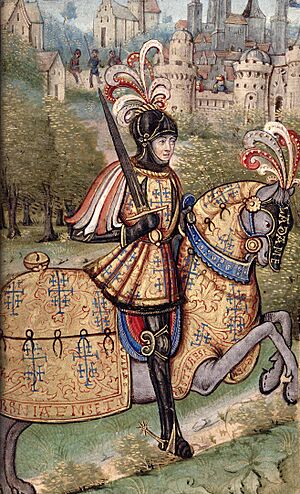René II, Duke of Lorraine facts for kids
Quick facts for kids René II |
|
|---|---|

René at the Battle of Nancy, as depicted in La Nancéide, 1518
|
|
| Duke of Lorraine | |
| Reign | 24 July 1473 – 10 December 1508 |
| Predecessor | Nicholas I |
| Successor | Antoine |
| Duke of Bar | |
| Reign | 23 March 1483 – 10 December 1508 |
| Predecessor | Yolande |
| Successor | Antoine |
| Born | 2 May 1451 Angers |
| Died | 10 December 1508 (aged 57) Fains |
| Spouse |
Philippa of Guelders
(m. 1485) |
| Issue |
|
| House | Lorraine |
| Father | Frederick II of Vaudémont |
| Mother | Yolande of Lorraine |
René II (born May 2, 1451 – died December 10, 1508) was an important ruler in Europe. He was the Count of Vaudémont starting in 1470. Later, he became the Duke of Lorraine in 1473 and the Duke of Bar in 1483. He also had claims to the crowns of Naples and Jerusalem.
Contents
Life of René II
René was born in a city called Angers. His parents were Yolande of Lorraine and Frederick, Count of Vaudémont. He spent his younger years with his grandfather, René I of Anjou.
Becoming a Ruler
In 1470, René took over from his father as the Count of Vaudémont. Three years later, he became the Duke of Lorraine. At this time, Lorraine was caught between two powerful rulers: Louis XI of France and Charles the Bold of Burgundy.
René first sided with Charles the Bold. However, Charles started to put his soldiers in Lorraine. Because of this, René secretly made an alliance with Louis XI in 1474.
The Burgundian Wars
Charles the Bold invaded Lorraine, and René had to leave Nancy in 1475. But René got the city back in 1476. He then went to Switzerland to hire an army of skilled Swiss mercenaries. With this army, René fought Charles the Bold at the Battle of Nancy on January 5, 1477. René won the battle, and Charles was killed. This victory ended the Burgundian Wars.
After his grandmother passed away in 1476, René also became the sole Count of Harcourt and Baron of Elbeuf.
Dealing with France
René's alliance with King Louis XI of France did not last long. Louis XI wanted to take over some of René's lands. In 1478, Louis XI gave René rights to lands that used to belong to Burgundy, like the Duchy of Luxembourg and the County of Burgundy. This was meant to make up for Louis taking other lands.
The County of Burgundy was given to France in 1482 with the Treaty of Arras. This made it possible for René to claim it. However, the County was given back to the Habsburg family in 1493 with the Treaty of Senlis. So, René never really controlled it. His power over Luxembourg was also mostly just on paper.
Duke of Bar and Italian Claims
In 1480, René became the Duke of Bar. In 1482, he took over a small area called Virton, which was part of Luxembourg, and added it to Bar. In 1484, the regent for the young French king officially made René the Duke of Bar.
When his mother, Yolande, died in 1483, René inherited her claims to the kingdoms of Naples and Jerusalem. In 1482, René traveled to Italy. He helped the Republic of Venice defeat the Duke of Ferrara in a battle.
In 1485, René was involved in a conflict known as the "Mad War" in France. However, he wisely decided to leave the fighting after a short time. In 1488, people in Naples offered him their crown. René started an expedition to take control of Naples. But the new French king, Charles VIII, stopped him because Charles wanted Naples for himself.
In 1495, René settled a disagreement with his cousin over family inheritance. He gave up the county of Harcourt but received the county of Aumale in return.
Death
René became sick while he was hunting in Fains. He passed away on December 10, 1508, at the age of 57.
Family
René's mother, Yolande, was the granddaughter of Isabella, Duchess of Lorraine. His father was from the Vaudémont family, which was a branch of the Lorraine ducal family. This meant René was the rightful heir to the Duchy of Lorraine when his cousin Nicholas died in 1473.
René married Philippa of Guelders in Orléans on September 1, 1485. They had several children:
- Charles (born 1486); died young
- Francis (born 1487); died at birth
- Antoine, Duke of Lorraine (1489–1544)
- Nicholas (born 1493); died young
- Claude, Duke of Guise (1496–1550); he became the first Duke of Guise
- Jean, Cardinal of Lorraine (1498–1550)
- Louis, Count of Vaudémont (1500–1528)
- François, Count of Lambesc (1506–1525)
- Anne (1490–1491)
- Isabelle (1494 – before 1508)
- Claude and Catherine (twins) (born 1502); died young
See also
 In Spanish: Renato II de Lorena para niños
In Spanish: Renato II de Lorena para niños

